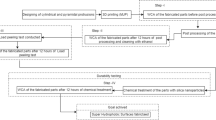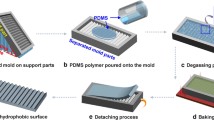Abstract
In this study a novel and straightforward 3D printing method based on inkjet printing process for the design of superhydrophobic surfaces was investigated. In particular, a novel sol-gel solution was designed and used with a modified 3D printing approach based on micro-solenoid inkjet printing. The study focuses on the impact of roughness and chemical composition - both crucial factors in achieving superhydrophobic properties - by measuring the contact. In addition, tilt angle of water droplets on different coating were determined. It is believed that the simple new inkjet printing method presented here can expand the application of the superhydrophobic high and low adhesive surface on different substrates for application in many industrial fields.







Similar content being viewed by others
References
Chen W, Fadeev AY, Hsieh MC, Oner D, Youngblood J, McCarty TJ (1999) Ultrahydrophobic and ultralyophobic surfaces: some comments and examples. Langmuir 15:3395–3399
Li XM, Reinhoudt D, Crego-Calama M (2007) What do we need for a superhydrophobic surface? A review on the recent progress in the preparation of superhydrophobic surfaces. Chem Soc Rev 36:1350–1368
Cassie BD, Cassie ABD, Baxter S (1944) Wettability of porous surfaces. Trans Faraday Soc 40:546–551
Moulinet S, Bartolo D (2007) Life and death of a fakir droplet: impalement transitions on superhydrophobic surfaces. Eur Phys J E 24:251–260
Manoharan K, Bhattacharya S (2019) Superhydrophobic surfaces review: functional application, fabrication techniques and limitations. J Micromanuf 2:59–78
Taurino R, Fabbri E, Messori M, Pilati F, Pospiech D, Synytska A (2008) Facile preparation of superhydrophobic coatings by sol–gel processes. J Colloid Int Sci 325:149–156
Nakajima A, Fujishima A, Hashimoto K, Watanabe T (1999) Preparation of transparent superhydrophobic boehmite and silica films by sublimation of aluminum acetylacetonate. Adv Mater 11:1365–1368
Nakajima A, Fujishima A, Hashimoto K, Watanabe T (1999) Preparation of transparent superhydrophobic boehmite and silica films by sublimation of aluminum acetylacetonate. Adv Mater 16:1365–1368
Hozumi A, Takai O (1997) Preparation of ultra water-repellent films by microwave plasma-enhanced CVD. Thin Solid Films 303:222–225
Ogawa K, Soga M, Takada Y, Nakayama I (1993) Development of a transparent and ultrahydrophobic glass plate. Jpn J Appl Phys 32:L614
Sas I, Gorga RE, Joines JA, Thoney KA (2012) Literature review on superhydrophobic self-cleaning surfaces produced by electrospinning. J Polym Sci B Polym Phys 50:824–845
Guo Z, Liu W, Su B (2011) Superhydrophobic surfaces: from natural to biomimetic to functional. J Colloid Interface Sci 353:335–355
Cannio M, Boccaccini DN, Taurino R, Riva V, Gualtieri ML, Tognetti M, Hanuskova M, Cicconi M, Fey T, Rosa M, Novaresio V, Petaccia P, Romagnoli M, Boccaccini AR (2019) Digital Printing of Glass-ceramic Glazes, Ceram. in Modern Tech. https://doi.org/10.29272/cmt.2019.0010
Cannio M, Mortalò C, Prestianni M, Andreola F, Deambrosis SM, Miorin E, Zin V, Boccaccini DN, Romagnoli M (2021) Manufacturing of BaCe0.65Zr0.20Y0.15O3-δ-Ce0.85Gd0.15O2-δ structures by micro-extrusion 3D-printing. Mater Lett. https://doi.org/10.1016/j.matlet.2020.128970
Wang X, Cai X, Guo Q, Zhang T, Kobe B, Yang J (2013) I3DP, a robust 3D printing approach enabling genetic post-printing surface modification. Chem Commun 49:10064–10066
Zhang Y, Yin M, Ouyang X, Zhang AP, Tam H (2020) 3D μ-printing of polytetrafluoroethylene microstructures: a route to superhydrophobic surfaces and devices Appl Mater Today https://doi.org/10.1016/j.apmt.2020.100580
Li Y, Mao H, Hu P, Hermes M, Lim H, Yoon J, Luhar M, Chen Y, Wu W (2019) Bioinspired functional surfaces enabled by multiscale stereolithography. Adv Mater Tech 4:1–7
Han S, Sung J, So H(2021) Simple fabrication of water harvesting surfaces using three-dimensional printing technology. Int J Precis Eng Manuf Green Tech 8:1449–1459
Orsi G, De Maria C, Montemurro F, Chauhan VM, Aylott JW, Vozzi G (2015) Combinig inkject printing and sol-gel chemistry for making pH-sensitive surfaces. Curr Top Med Chem 15:271–278
Gvishi R, Sokolov I (2020) 3D sol–gel printing and sol–gel bonding for fabrication of macro- and micro/nano-structured photonic devices. J Sol-Gel Sci Technol 95:635–648
Derby B (2010) Inkjet printing of functional and structural materials: fluid property requirements, feature stability and resolution. Annu Rev Mat Res 40:395–414
Butt MA (2022) Thin-film coating methods: a successful marriage of high-quality and cost-effectiveness—a brief exploration. Coatings 12:1115–1136
Jang D, Kim D, Moon J (2009) Influence of fluid physical properties on ink-jet printability. Langmuir 25:2629–2635
Bhushan, B., Nosonovsky, M. (2012). Rose Petal Effect. In: Bhushan, B. (eds) Encyclopedia of Nanotechnology. Springer, Dordrecht. https://doi.org/10.1007/978-90-481-9751-4_157
Rotenberg Y, Rajagopalan L, Neumann AW (1983) Determination of surface tension and contact angles from the shapes of axisymmetric fluid interfaces. J Colloid Interf Sci 93:169–183
Machekposhti SA, Movahed S, Narayan RJ (2020) Physicochemical parameters that underlie inkjet printing for medical applications. Biophysics Rev 1:011301
Taurino R, Fabbri E, Pospiech D, Synytska A, Messori M (2014) Preparation of scratch resistant superhydrophobic hybrid coatings by sol–gel process. Prog Org Coat 77:1635–1641
Messori M, Toselli M, Pilati F, Fabbri P, Pasquali L, Montecchi M, Nannarone S, Tonelli C (2005) Perfluoropolyether-based organic-inorganic hybrid coatigs: preparation and surface characterisation. Surf Coat Int Part B: Coat Trans 88:243–249
Zhang J, Yue P (2020) A level-set method for moving contact lines with contact angle hysteresis. J Comp Phys 418:109636–109657
Feng L, Zhang Y, Xi J, Zhu Y, Wang N, Xia F, Jiang L (2008) Petal effect: a superhydrophobic state with high adhesive force. Langmuir 24:4114–4119
Widom B (2004) Capillarity and wetting phenomena: drops, bubbles, pearls, waves. Phys Today 57:66–67
Herminghaus S (2000) Roughness-indiced non-wetting. Eur Lett 52:165–170
Gersh OB, Eli R (2009) Contact angles of nanodrops on chemically rough surfaces. Langmuir 25:9285–9289
Author information
Authors and Affiliations
Contributions
TR wrote the main manuscript. CM and TR prepared graphical abstract. All authors reviewed the manuscript.
Corresponding author
Ethics declarations
Conflict of interest
The authors declare no competing interests.
Additional information
Publisher’s note Springer Nature remains neutral with regard to jurisdictional claims in published maps and institutional affiliations.
Rights and permissions
Springer Nature or its licensor (e.g. a society or other partner) holds exclusive rights to this article under a publishing agreement with the author(s) or other rightsholder(s); author self-archiving of the accepted manuscript version of this article is solely governed by the terms of such publishing agreement and applicable law.
About this article
Cite this article
Taurino, R., Cannio, M., Boccaccini, D.N. et al. Preliminary study on the design of superhydrophobic surface by 3D inkjet printing of a sol-gel solution. J Sol-Gel Sci Technol 108, 368–376 (2023). https://doi.org/10.1007/s10971-023-06193-9
Received:
Accepted:
Published:
Issue Date:
DOI: https://doi.org/10.1007/s10971-023-06193-9




